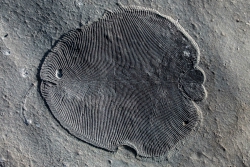Trending Science: Fat helps identify world’s oldest known animal
Earlier in 2018, the scientific community discovered the oldest known human fossil outside Africa. Now comes evidence of the oldest animal in the world, breaking a decades-long mystery. According to an article published in the journal ‘Science’(opens in new window), scientists have identified a mysterious creature called Dickinsonia as the oldest known animal in the geological record. The research team found specimens that were so well preserved they still contained molecules of cholesterol. The fat discovered on the fossil confirms that the oval-shaped organism lived 558 million years ago. This makes it the earliest known member of the animal kingdom. Dickinsonia belongs to a group of life forms known as the Ediacaran biota that represent the earliest known complex life on Earth. Scientists have had a very hard time trying to classify them. One of the greatest mysteries in palaeontology has been their position on the tree of life. The study reveals that Dickinsonia existed at least 20 million years before the Cambrian explosion event. That’s when major animals began appearing on the fossil record. The half-billion-year-old fossil was found in the Ediacara Hills in south Australia and first described in 1947. Since then, a debate has raged over its identity. Does the fossil finding settle a 70-year-old debate? “The fossil fat molecules that we’ve found prove that animals were large and abundant 558 million years ago, millions of years earlier than previously thought,” co-author and associate professor at the Australian National University Jochen Brocks told the ‘BBC’(opens in new window). “Scientists have been fighting for more than 75 years over what Dickinsonia and other bizarre fossils of the Ediacaran Biota were,” he added. “The fossil fat now confirms Dickinsonia as the oldest known animal fossil, solving a decades-old mystery that has been the Holy Grail of palaeontology.” Lead author and PhD student Ilya Bobrovskiy extracted and analysed molecules from inside the fossil, instead of examining its structure as scientists normally do. The Dickinsonia fossils contained very high levels of cholesterol molecules, reaching up to 93 %. “Most rocks containing these fossils, such as those from the Ediacara Hills in Australia, have endured a lot of heat, a lot of pressure, and then they were weathered after that - these are the rocks that palaeontologists studied for many decades, which explained why they were stuck on the question of Dickinsonia’s true identity.” Bobrovskiy was the one who made the discovery from fossils he extracted from a cliffside in the Russian White Sea region. “I took a helicopter to reach this very remote part of the world – home to bears and mosquitoes – where I could find Dickinsonia fossils with organic matter still intact,” he said about the adventure in an interview with the British newspaper ‘The Guardian’(opens in new window). “These fossils were located in the middle of cliffs of the White Sea that are 60-100m high. I had to hang over the edge of a cliff on ropes and dig out huge blocks of sandstone, throw them down, wash the sandstone and repeat this process until I found the fossils I was after.” Fat has helped to crack the fossil mystery. Now the strange-looking creature will provide important clues in understanding the appearance and evolution of our own earliest ancestors.
Countries
United States



